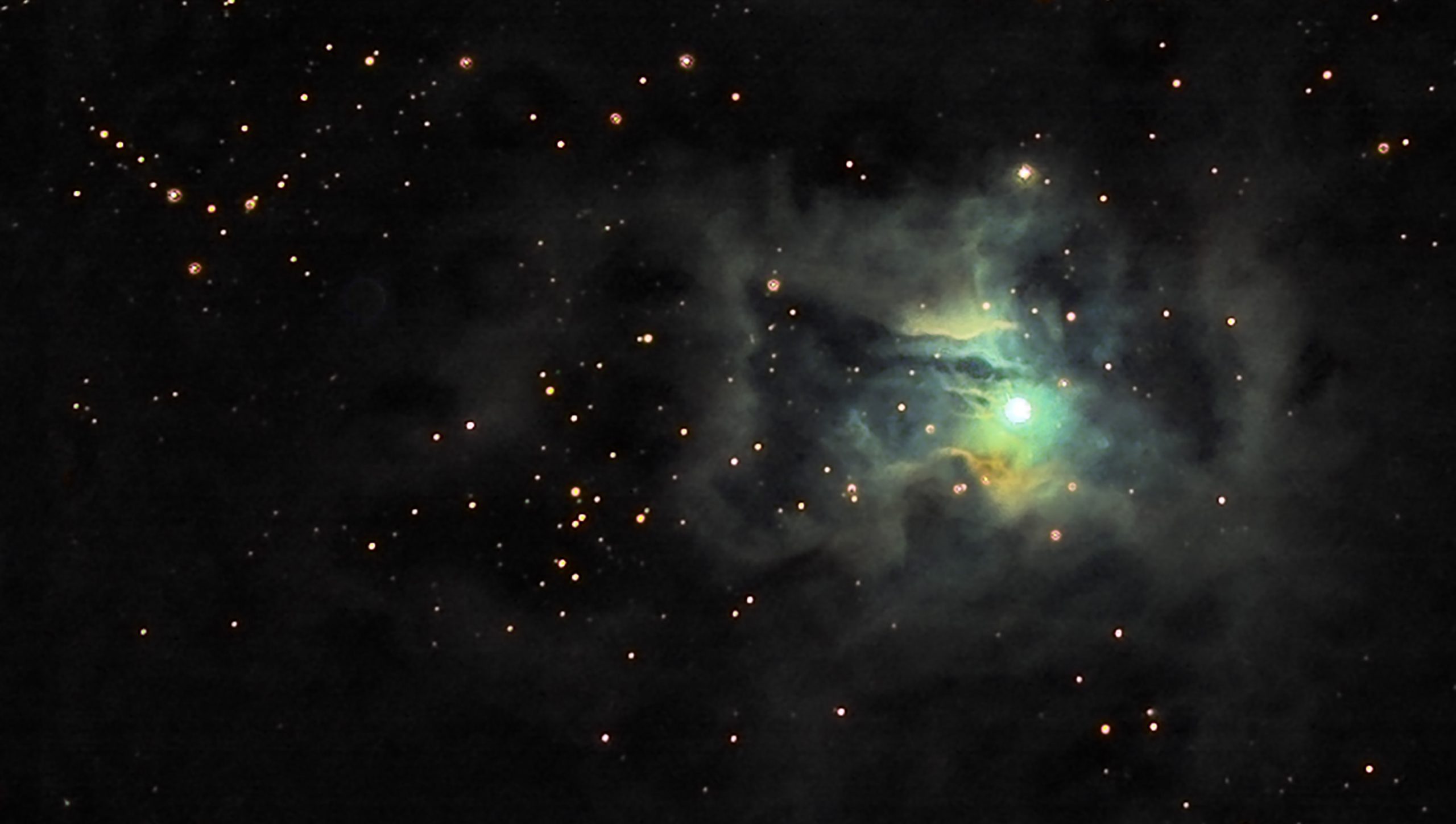A Different Theory of Dark Matter/Energy
Summary
The intention here is to provide a possible alternative hypothesis to some fundamental questions plaguing the scientific community:
1. The fact that star systems rotate too fast around their respective galactic centers at a rate that cannot be explained by the available mass that can be observed.
2. Where does the energy come from causing the galaxies to be accelerating away from each other?
3. And finally the shortage of mass available during the early start of the universe in order for the galaxies to have formed.
Absolute proof of these hypotheses will not be presented, but hopefully sufficient plausibility to warrant further study.
Table of Contents
Page
Modified Newton Gravity Equation
Issue1: Star Systems Rotating too Fast
Issues 2&3: Energy for accelerating universe and missing mass from early universe
Effect of a negative gravitational force at the polar ends of a rotating mass.
Dark Energy/Missing Mass
Refuting the Proposed Hypothesis
3
5
5
9
13
14
Modified Newton Gravity Equation
This hypothesis hinges on whether gravity is considered to be a force wherein each bit of mass exerts a force on every other bit of mass or if instead we consider gravity to be the result of a distortion of space itself by the presence of a mass. The reason to consider this difference is as to how the shape of the mass affects the space surrounding it. If the latter is the case we might rewrite Newton’s gravitational law as follows:
F = G*4*π*M*m/A – where A is the surface area extending out from the mass in question.
Therefore space is distorted or the force is inversely proportional to the surface area emanating from the center of a spherical mass.
A way of looking at this would be to consider the mass in question to be at the bottom of a well and that the contour of the well would become less and less steep as you progress away from the bottom of this well.
It might be asked, how this adds to the discussion as it is just another way of saying the same thing. The difference comes when we start to consider other shapes than just a perfect sphere. What happens if we have a very long thin cylinder with the same mass? How would the space around this mass be distorted? It is suggested that we would now have the formation of a trough emanating from this mass perpendicular to its axis.
The formula then becomes: F =G*4*π*M*m/(2*π*r*L) where L equals the length of the mass.
Thus the gravitational force varies with 1/r instead of 1/r^2 as the case with a spherical mass.
In the case of galaxies which have a core which is spinning at very high velocities their shape becomes elliptical and not spherical so their effect on distorting space would start to approach that of a thin cylindrical mass and therefore the gravitational effect would also approach 1/(2πrL) instead of 1/(4πr^2). It then might be expected that there would be a higher gravitational force in the area perpendicular to the center of this ellipsoid and it would vary with 1/r instead of 1/r^2.
Issue number two (where does the energy come from for the accelerating universe) can be explained by assuming that there is an engine within the universe that can convert mass into the kinetic energy which is being accumulated by the accelerating expanding universe. One possible source for this engine are the high speed rotating black holes and that this is achieved by a narrow negative gravitational force emanating parallel to the axis of rotation. Again the assumption is that this force varies with the inverse of the distance from the axis (1/r).
The explanation of issue number 3 flows from the explanation of issue number 2. If mass has been converted to kinetic energy over time, than there would have to have been more mass in the early universe. If one does the calculation it will be seen that the missing mass that scientists feel must have been present in the early universe can be accounted for by the extra energy that is observed in the rapidly expanding universe.
It is not intended to provide proof of the hypotheses, but to provide enough plausibility to encourage others to seek to confirm or deny what is being proposed.
Issue 1:
Star systems are rotating too fast around their respective galactic centers at a rate that cannot be explained by the available mass that can be observed.
Let us consider that the bulge in the Milky is an circular wedge and not a Sphere.

Assumptions: Volume = 2*π*r^2*t
where
r = 12,000/2 ly (ly = light years)
t = 3,300 ly
velocity of solar system around Milky way = 230,000 m/s
Thickness of outer ring of star systems in Milky Way = t = 1,000 ly
Let us calculate the mass in volume t of the ellipsoid based on the equation:
F = G*2*Mt *m/(r*t) = m*v^2/r
This becomes: Mt = v^2*t/2/G = 230,000^2*3300*1E16/2/6.7E-11 = 1.18E+40 kg.
It is claimed that this inner bulge is about 1/6th of the overall mass of the Milky Way. Thus the overall mass would = 1.18E40*6 = 7.06E40 kg.
This would seem to be in the ball park of most Milky Way Mass estimates (excluding the so-called Dark Matter)
Obviously these calculations are not quite as simplistic as I have shown them to be, but do present some reasonableness to the thought process.
Issues 2&3:
Energy for accelerating universe and missing mass from early universe
Where does the energy come from for the accelerating universe and where is the missing mass required for the formation of the galaxies we have today:?
The fundamental answer to both these questions lies in the consideration that there is an engine in the universe that converts mass to the kinetic energy being created in the accelerating universe. This both answers the question of where the energy comes from and explains the extra mass that needed to be in existence in the early universe.
To know the mass of the early universe it would be necessary to add up how much mass would have had to be converted to explain the present day energy state of the universe.
One possible explanation for this engine that is being suggested here is that gravity is produced (both positive and negative) by means of extreme masses rotating at extreme velocities at the center of most galaxies – in particular massive black holes.
It is suggested that a positive gravitational force is produced perpendicular to the axis of the rotating mass and a negative force is produced parallel to the axis of the rotating mass.
The following are some of the assumptions being made:
- The kinetic energy of a rotating mass can curve space and time and thus generate what seems to be a gravitational force.
- This effect is only noticeable at masses similar to black holes and rotational velocities approaching the speed of light.
- There is insufficient kinetic energy even in our sun to generate a measureable effect on objects within the solar system.
- This curving of space and time is non-uniform.
- At the equator of the rotating black hole the curvature of space is such that mass in its vicinity will tend to move toward it.
- At the ends of the rotating axis the curvature is such that mass will move away from it.
- This force varies with the inverse of the distance from the rotating object rather than with the inverse of the square of the distance as is the case with the normal Newtonian gravitational force.
Let us consider (as before) rewriting Newton’s gravitational equation by replacing (M) mass with its equivalent M= E/c^2 where E is the Kinetic Energy embodied by the rotating mass.
Thus: F = 4*π*G*KE*m/(c^2*A). If the mass is a long cylindrical body or even for a hockey puck shaped body then A = 2*π*r*L – where r = distance from axis and L = length of cylinder or the thickness of the hockey puck shape (This is for the force emanating parallel to the radius.
Newton’s equation then becomes: F = 2*G*KE*m/(c^2*r).
For a solid spherical mass KE = 1/5*M*v^2 – where v = velocity of surface of mass m/s.
If the calculation is done it will be seen that this is an extremely week force and would only become significant when extreme masses rotate at speeds close to that of light.
In fact: a 1,000 kg mass rotating at 10,000 rpm would only exhibit a 1.1E-16 newton force on a 100 kg mass located 1 meter from it. This would be extremely difficult to measure.
Effect of a negative gravitational force at the polar ends of a rotating mass.
There is no scientific basis for making this assumption other than the observed emissions emanating from the ends of various galaxies in photographs.
However, just to examine the plausibility of such a hypothesis we can do the following calculation based on the equation determined for a rotating mass.
How far would a mass travel if it was subjected to the repulsive forces presumed to be emanating from the axial ends of the mass rotating at the center of our galaxy.
Let us assume that a mass equal to that of our solar system is sitting at a distance just beyond where the rotational forces of the rotating center are greater than the Newtonian gravitational forces.
We know that F = ma where F is the force, m is the mass the force is acting on and a is the acceleration being experienced by this mass.
a = F/m
a = dvs/dt
If we integrate we get
vs =( F/m)*t + vo
Where vs = velocity of above mass
vo = initial velocity
Here I will assume that the area perpendicular to the rotational axis is (1/D + x^.5)^2*3.1416
Knowing that vs = dx/dt and F = G/(c2 *(.5*D+x^.5))^2*.2*M*V2 *m
x = distance travelled
Then
x dx/dt = G/(c2 *(.5*D+x^.5))*.4M*V2 *t + vo
Let us assume that vo = 0
Integrating and transposing we get:
x2/2 = G/(c2 *(.5*D+x^.5) )^2*.4*M*V2 *t2 /2 + vo*t +xo
x = (G/(c2 *D )*.4*M*V2 *t2 + 2*xo ) 0.5
t = time traveled
V = 1.67% speed of light
Assuming vo = 0 is most certainly a bad assumption as it would be expected that at a time not to long after the big bang that vo would in all likelihood be close to that of the speed of light. However, in light of not knowing what it was we’ll assume it to be zero.
xo is essentially 0.
During the early age of the universe and the scale of distances we are looking at today, this is probably not a bad assumption.
If the age of the universe is 14 billion years and we insert this than we would calculate the distance traveled from the start of the universe to be 27 million light years. This is obviously not sufficient to get out to the 14 billion light years we presently see. However, if we use a mass 500 times that of the black hole at the center of our Milky Way and a rotational velocity of 1.67% of that of light or using the mass to be the same as presently in our milky way and a rotational velocity of 37% the speed of light we start to get numbers much closer to that of the 14 billion light years that is the presently accepted age of the universe. In any case this is speculation at this point in time.
The other issue with this hypothesis has to do with the narrowness of this negative gravitational force. It must be in the form of a cone emanating from the axis of the black hole. This would cover only a small part of the volume of the universe and could not explain how all parts of the universe seem to be expanding uniformly. However if we look at the number of galaxies in the universe and assume a random distribution it is quite easy to determine that there are a sufficient number of galaxies to cover every cubic centimeter and thus this expansive force would be distributed relatively evenly.
It does show that this hypothesis (although maybe not probable) it is a possibility.
The following diagram illustrates what this cone would look like over 500 light years: (assuming that the force varies with 1/r and r being the distance from the poles of the rotating black hole).

The other issue is to try and disprove the hypotheses
This emanation from each end of rotating black holes seems to be a common occurrence.

Dark Energy
Where does the energy come from to explain the expanding universe?
- What can we learn from recent data in regard to the accelerating expansion of the universe?
The following is some of the recent information that has been learned.
The universe is expanding at a rate of 74.3 km/sec for every mega parsec (approximately 3,000,000 light years). This translates into an acceleration rate of 7.85E-10 m/sec/sec. - The acceleration seems to have started approximately 5,000,000,000 years after the big bang.
From this information it is possible to estimate the Mass of the universe at this point in time.
The force necessary to generate this acceleration of a certain mass = F = ma,
Where:
F = force in newtons
m = mass being accelerated and
a = the acceleration of the mass in question.
M = mass of universe
Likewise the force at 5 billion light years opposing this expansionary force would =
F = G*M*m/r^2
Assuming that these two forces are equal at 5 billion light years we get:
F = G*M*m/r^2 = ma
m cancels on both sides of the equation and we can calculate the Mass of the universe at this point in time.
Thus: M = a*r^2/G
Inputting the data at 5 billion light years we get M = 2.62E+52 kg.
This compares to present estimates of 6.17E+51 kg (not including dark matter estimates).
This shows a discrepancy of 1.94E52 kg between now and 5 billion years ago.
What happened to this extra mass?
Can this missing mass account for the accelerating universe?
What is causing the universe expansion to be accelerating and where does this extra energy come from.
We can use the previous data to access the order of magnitude of energy that might be required to accelerate the expansion of the universe.
The energy required to accelerate a given mass from the 5 billion light year mark to the 14 billion light year mark which is the accepted age of the universe is as follows:
Where E = energy – joules
F= Force (newtons)
R = distance from 5 billion light years to 14 billion light years or 9 billion light years.
m = a given mass
a = acceleration
E = F*R = m*a*R
Thus E = m*7.85E-10*8.51E+25 (joules)
- Where does this massive amount of energy come from?
There seems to be three possibilities:
There is energy being transferred into our universe from a source outside our universe. (a part of the multiverse hypothesis) - Space itself has some inherent energy built into it that can be transferred to kinetic energy.
- I’d like to offer another possibility. The energy required for this kinetic energy comes from some form of “engine” that can transfer the energy located in mass itself into the presently observed kinetic energy.
We know from Einstein’s equation that mass contains the following amount of energy:
E = m1*c^2
Where:
E = energy – joules
m1 = a given mass
c = speed of light.
For purposes of this discussion let us determine the fraction of mass that would have to be converted to energy to allow m to accelerate over 9 billion light years.
Thus:
The fraction of mass to be converted would = m1 /m = 7.85E-10*8.51E+25/c^2 = 0.74 or 74% of the mass would have to be converted to kinetic energy.
If we apply this to the total mass of the universe than 74% of the mass of the universe would have to have been converted to kinetic energy in order to maintain the law of conservation of mass and energy.
This means that 74% of the 2.62E+52 kg would have to have been converted over the 9 billion years. This amounts to 1.94+52 kg.
If we subtract this from the 2.62E+52 we get 6.52E+51 kg.
This is remarkably close to the present estimate of the mass of the universe.
How might this hypothesis be refuted:
A few areas which could be looked at are:
- Locate star systems that are well outside the narrow zone perpendicular to the axis of rotation of the central black hole that are circling at a higher rate than can be accounted for by the observable mass.
- Identify galaxies that are not elliptical in shape and still have star systems travelling too fast for the observable mass. (Galaxies have already been identified which do not have a black hole at their center and they do not exhibit the effects of so called dark matter)
- Conduct a laboratory experiment that could measure the rotational gravitational effect that is being proposed. This would require extremely sensitive measurements. This would be extremely hard to do as the calculation suggests that a 10000 kilogram steel ball rotating at 10000 rpm would only exhibit a force of 1.1E-16 newtons on a 100 kilogram steel ball one meter from the larger ball.




